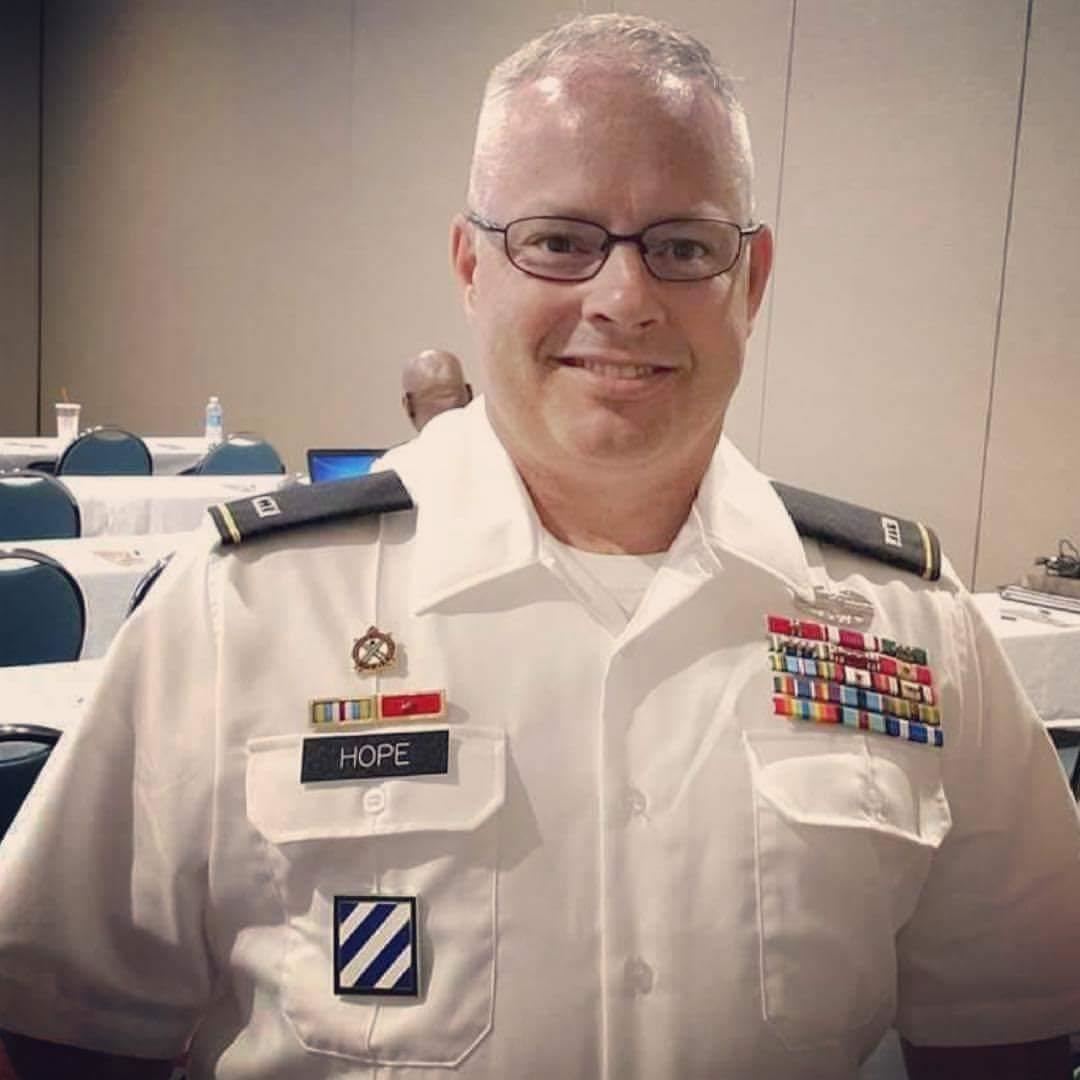WELCOME
DEPARTMENT OF THE ARMY
ARMY JROTC
Bobcat Battalion
DOOLY COUNTY HIGH SCHOOL
715 3rd St.
Vienna, Georgia 31092
18 June 2024
Dear Parents, Guardians, and Students of Dooly County High School Army Junior Reserve Officer Training Corps (JROTC) Battalion;
I welcome you to the Dooly County High School "BOBCAT" Battalion and look forward to a great year of exciting and rewarding learning opportunities.
I would like to take a moment to introduce myself to you. I am Chief Warrant Officer 3 (Retired) Troy C. Hope, United States Army. I grew up in Brunswick, GA, where I attended both Brunswick High School and Glynn Academy. In 1993, I joined the US Army as a welder and a machinist. I achieved my rank of CW3 in October of 2008. I served 23 years in the Army and retired in 2015 from the Ordnance Corps. I took a position as the Senior Army Instructor at Dooly County High in January 2022.
Our goals for the cadets in the BOBCAT Battalion are:
· To appreciate the ethical values and principles that underlie good citizenship.
· To develop leadership potential while living and working cooperatively with others.
· To be able to think logically and to communicate effectively with others, both orally and in writing.
· To appreciate the importance of physical fitness in maintaining good health.
· To understand the importance of high school graduation for a successful future and learn about college and other advanced educational and employment opportunities.
· To develop mental management abilities.
· To become familiar with military history related to America's culture and understand the history, purpose, and structure of military services.
· To develop the skills necessary to work effectively as a team member.
During the upcoming school year, Dooly County High School will embrace traditional instruction with students in the classroom. The coursework in JROTC is divided into four Leadership, Education, and Training (LET) levels that correspond to the four years of high school. The LET I and II cadets will be instructed by the Army Instructor and LET III & VI will be combined under the control of the Senior Army Instructor. LET III VI cadets will conduct instruction for the LET I & II levels at the discretion of the instructors. Our instructional schedule is as follows: Monday and Wednesday are Academic days, Tuesday is Uniform & Drill, Thursday is Physical Training (PT), and Friday is Leadership Lab.
I look forward to talking to you throughout the year and forming a working relationship with you and your respective cadet(s). My door is always open to any student, cadet, parent, or guardian. Feel free to contact me at the school number, (229) 268-8181 or email me at troy.hope@dooly.k12.ga.us
Troy C. Hope
CW3,SAI
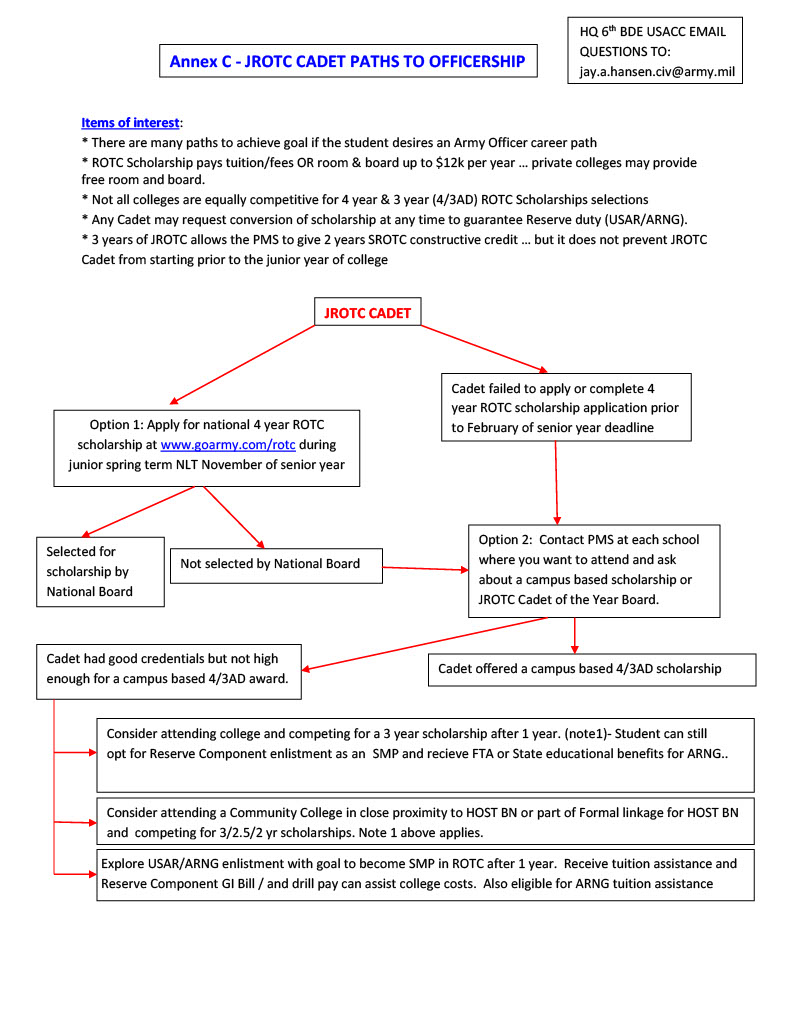
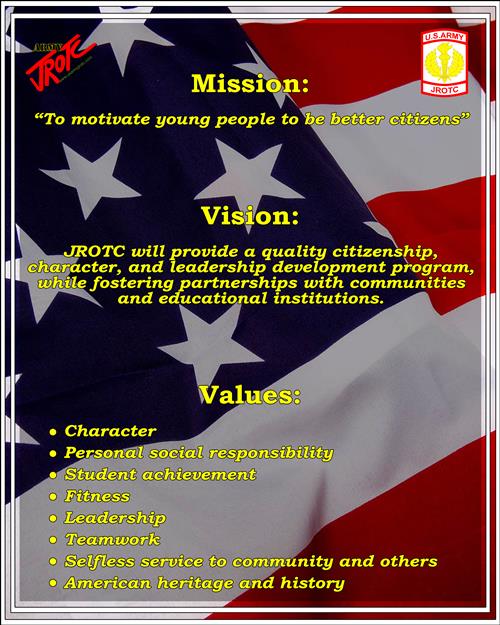
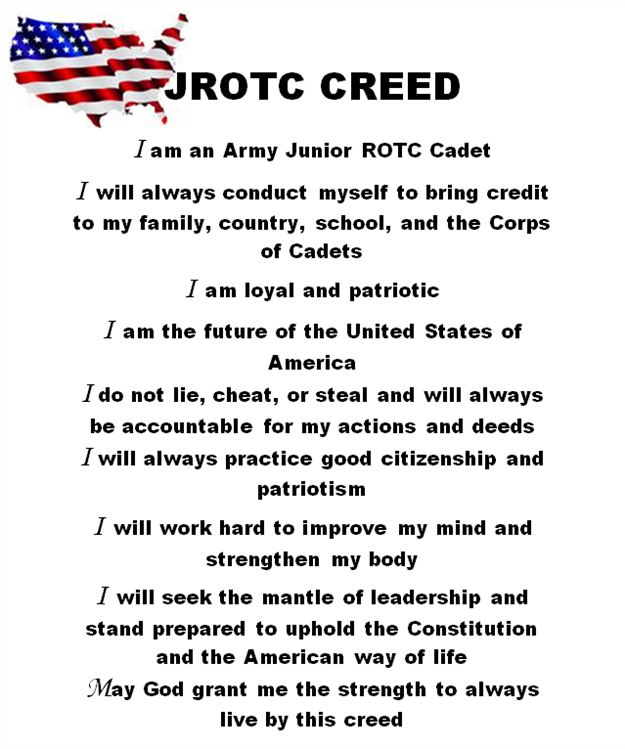
Course Syllabus
Dooly County High School
JROTC Course Syllabus
SY2022-2023 LET 1, 2, 3, & 4
COURSE NAME AND NUMBER:
JROTC Leadership, Education and Training (LET), Levels 1-4INSTRUCTOR(S) NAMES AND RESPONSIBILITIES:
Senior Army Instructor (SAI) CW3 (Retired) Troy C. Hope
(229) 268-8181/ troy.hope@dooly.k12.ga.us
Army Instructor (AI) SFC Cordle, Stephens
TEXTBOOK NAME AND NUMBER:
U.S. Army-issued JROTC Textbooks.COURSE DESCRIPTION:
The Dooly County High School Junior Reserve Officer Training Course (JROTC) is a military-based, congressionally authorized, and funded course designed for high school students. It is a four-year program that emphasizes citizenship, government, and leadership, with the program’s primary focus reflected by the mission statement, “To motivate young people to be better citizens.” It is designed to teach high school students the value of citizenship, leadership, service to the community, personal responsibility, and a sense of accomplishment while instilling in them self-esteem, teamwork, and self-discipline. The Dooly County High School JROTC program is part of the Department of Defense's commitment to America’s Promise for Youth through its emphasis on service learning, community service, and anti-drug efforts.COURSE OBJECTIVES:
The Dooly County High School JROTC program helps to prepare students for responsible leadership roles while making them aware of their rights, responsibilities, and privileges as American Citizens. The program is a stimulus for promoting graduation from high school, and it provides instruction and rewarding opportunities that will benefit the student, Dooly County High School, the surrounding community, and the Nation. Specific program outcomes describing what Dooly County High School JROTC Cadets will know and be able to do upon successful completion of the course include:Maximizing potential for success through learning and self-management.
b. The development of leadership skills.
c. Incorporating principles of mental and physical wellness into behaviors and decisions.
d. Building effective relationships with peers, co-workers, and the community.
e. Applying physical and political geography to building global awareness.
f. Correlating the rights and responsibilities of citizenship to the purposes of the U.S. Government.
g. Relating events in U.S. History to choices and responsibilities Americans have today.
h. Characterizing the role of the military and other national service organizations in building a democracy and maintaining peace in a democratic society.
The Dooly County High School JROTC curriculum also aids in the development of broad, life-long skills that are essential for success in the cadet’s life and future roles. These skills are not learned in one lesson or LET level but are linked to lesson competencies and integrated throughout the curriculum. Additional core abilities that each cadet will learn to include:
a. Building the capacity for life-long learning.
b. Communicating using verbal, non-verbal, visual, and written techniques.
c. Taking responsibility for your actions and choices.
d. Doing your share as a good citizen at Dooly County High School, our community, country, and the world.
e. Treating yourself and others with respect.
f. Applying critical thinking abilities.
COURSE PREREQUISITES.
Enrollment in the Dooly County High School JROTC program is strictly voluntary, however some restrictions do apply. All cadets must participate in all JROTC events, including marching and physical fitness, and parents are required to certify that they are in good health and able to participate in these activities. Dooly County High School JROTC classes are taught sequentially beginning with the freshman year and build on the skills learned in prior years. A cadet will not be allowed to re-enroll in the Dooly County High School JROTC Program if they received a failing grade in JROTC in the prior academic year.CONTENT.
The Dooly County High School JROTC curriculum is a 180-hour academic program awarding full elective credit for each year completed. For each year completed there are additional credits embedded in the program. Each year is taught sequentially (starting with LET 1 and progressing through LET 4), and is a required prerequisite for the next. The Dooly County High School JROTC curriculum is characterized by active learning and is aligned with the McRel (Mid-continent Research for Education and Learning) national standards. The curriculum also includes several additional activities unique to the JROTC cadets, such as the Drill Team, Raiders Team, the Color Guard, and the Rifle Team, along with associated competitive events, Formal Inspections, and meetings. There is also the opportunity to attend a one-week summer camp that stresses adventure-type training and leadership skills training. Finally, there will be voluntary events such as the military ball and Veteran’s Parade scheduled each year.
Specific courses and hours taught to each LET level include the following:
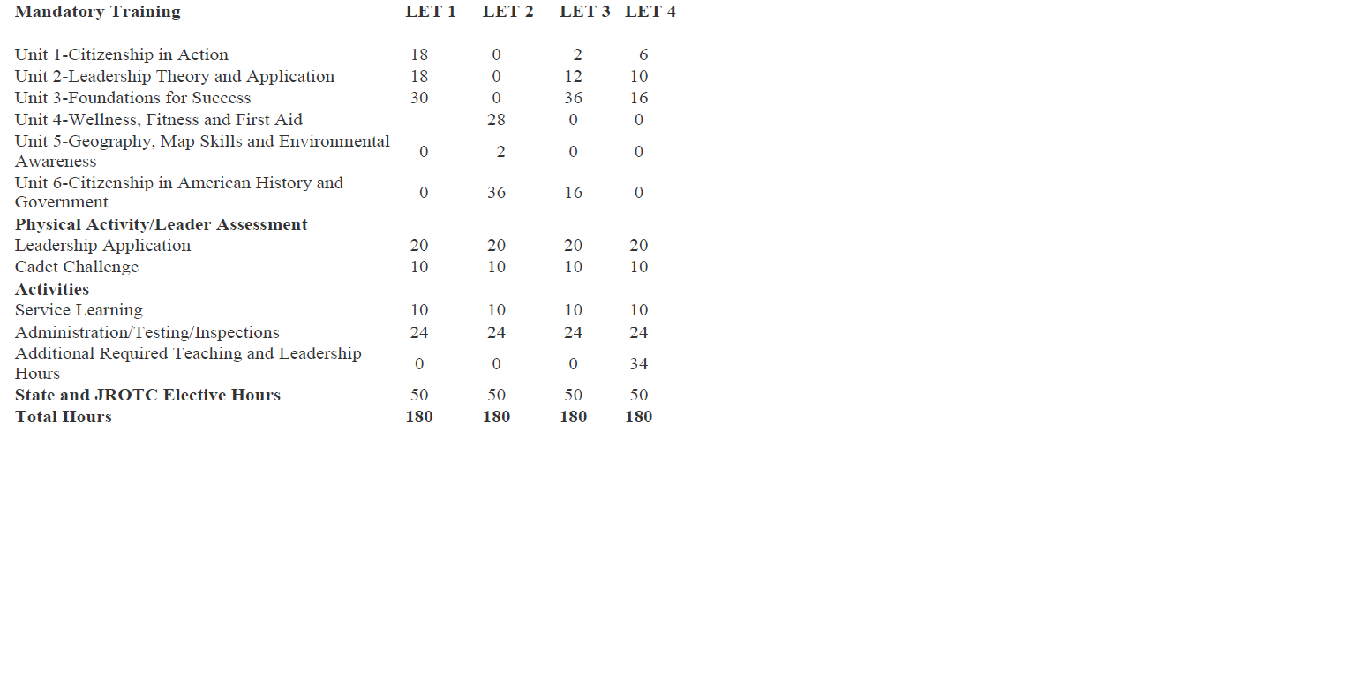
8. DATES TO REMEMBER AND DEADLINES.
Specific guidance and information about major events will be handed out or posted in the classroom, briefed to all cadets and sent home to parents as applicable. While cadets are expected to attend and participate in class and all JROTC events, some events are classified as mandatory. Missing a mandatory event will result in the cadet receiving a zero for that event. The only exceptions will be if there is a verified family emergency (such as a death or serious injury) or if a doctor’s excuse is presented.
9. Notable events requiring emphasis are the Military Ball, Veterans Day Parade, and the Formal Inspection or RFI. Participation in Summer Camps and Junior Cadet Leadership Camp (JCLC) is strongly encouraged.
10. Weekly Uniform Days. Uniform wear and personal appearance comprises 50% of a cadet’s grade. Cadets will wear the complete U.S. Army cadet uniform Class-B on uniform day. The uniform will be worn for the entire school day and will be worn correctly at all times. Refer to the Cadet Handbook for more specific grading and uniform wear information.($10.00 Dry cleaning fee required at time of uniform issue)
11. Special Team Practices. Drill Team, Color Guard, and Rifle Team will be performed Monday through Thursday and will be briefed by the instructor in class, however, for general planning purposes these teams will practice per a set schedule determined by the team coach and captain. Team Standard Operating Procedures (SOP) are available on the JROTC Website.
9. MATERIALS/EQUIPMENT/RESOURCES.
10. Items required of cadets. All cadets must have a signed parental release and statement of health on file to remain in and participate in JROTC. There are no exceptions to this policy. These forms will be handed out in class to bring home and cadets will return the signed release within the first two weeks of school, or they will be unenrolled from the Dooly County High School JROTC program. All cadets must bring a notebook and pen/pencil to class daily. All cadets will be required to have a serviceable pair of running or good walking shoes and suitable physical training clothing (either black shorts and JROTC t-shirt or sweatpants and JROTC t-shirt for colder months). The Cadets will be issued a JROTC t-shirt for TBD dollars that is required to be worn for PT.
11. All cadets will be issued and sign for a complete U.S. Army cadet uniform. It is the cadet’s responsibility to maintain all uniform items in good condition, including dry cleaning if necessary or as needed. If items of the uniform are lost or damaged it becomes the cadet’s responsibility to replace the item(s) by paying for them. If the cadet is unenrolled from the program or leaves Dooly County High School all uniform items must be dry-cleaned and turned back into the Dooly County High School JROTC Department and all missing items paid for or the cadet will not receive final grades and transcripts from the school.
12. EVALUATION AND GRADING.
Cadets are constantly being evaluated whether in JROTC class or not. In addition to the school policies on grooming and behavior, which will be adhered to by all cadets, there are additional policies that are unique to the Dooly County High School JROTC program. Generally, if a cadet is where they are supposed to be when they are supposed to be there and doing what they are supposed to be doing to the best of their abilities, they will receive a good grade in JROTC.
13. Grading Categories. The semester grade will be composed of the following items and percentages.
Cadets will be graded as follows
MINOR (CLASS WORK)
30%
MAJOR (Wear of the Uniform)
50%
Finals/LET Completion
20%
Expectations:
Electronic Portfolio: The cadet will be required to develop and maintain an electronic portfolio that will need to be maintained throughout the four years of the program.
Homework: The cadets will occasionally have homework to complete as many of our assignments are broken down into smaller lessons with a project at the end.
Essays: There will be at least one essay due during each school year as this is a requirement by the JROTC.
1. For each year of JROTC completed they will receive additional credits embedded in the program
LET 1 Elective Credit
LET II Elective Credit
LET III Elective Credit PE/Health
LET IV Elective Credit Honors in Leadership
1. Mandatory events. Mandatory events are of critical importance to the overall success of the Dooly County High School JROTC program. Missing a mandatory event without valid excuse (prior approval from the Senior Army Instructor or Army Instructor) will result in a grade of zero for the missing event that will be averaged into the cadet’s overall semester grade. Missing a uniform day without a valid excuse (prior approval from the Senior Army Instructor or Army Instructor) will result in a grade of zero for the missing event that will be averaged into the cadet’s overall semester grade.
Classroom Conduct
Teacher Expectations: I expect every student to participate in the JROTC program both in school and outside of school hours. This is a leadership development course and as such requires the cadets to be able to demonstrate the skills they have learned in various environments.
NO CELL PHONES, HEADPHONES, EARBUDS OR NON SCHOOL ISSUED ELECTRONICS ALLOWED If you have any questions please see the school handbook on this subject. After the syllabus has been read and signed the electronics will be confiscated if seen in class.
Class Attendance: All students are required to attend all classes unless otherwise excused by their instructors in writing.
Student Signature______________________ Date___________
Parent Signature _______________________ Date___________
Instructor Signature_____________________ Date __________
JROTC Enrollment Requirements
To be eligible for enrollment and continuance as a member of the JROTC unit, each student must meet the following requirements:
a. Grade. The student must be in a grade above the eighth grade during the school year of enrollment and attending Dooly County High School.
b. Academic standing. The student must maintain an acceptable standard of academic achievement and standing as required by the JROTC program and host institution.
c. Conduct and character. Cadets must maintain an acceptable standard of conduct. Those in leadership positions are expected to demonstrate high personal standards in order to set the example. All cadets should be honest, self-reliant, and have a sense of personal and social responsibility in performing unit and other academic assignments. They must exhibit self-discipline and respect for constituted authority through observance of laws, rules, and regulations; by prompt and regular attendance at instruction; and in their general demeanor. Cadets who fail to meet standards will be removed from leadership positions. All cadets will be screened at the end of each school year and will only be readmitted to the program with the approval of the SAI.
d. Physical ability. The student must be able to participate in the physical education program in the school. This requirement, under the secondary school’s open enrollment policy and when desired by the principal and SAI of the school, may be waived. However, the school will provide any special equipment or additional instructors that may be needed to instruct these students at no cost to the government. The school must also work with the instructor to ensure these students do not cause disruption to the presentation of the JROTC curriculum.
e. $10.00 Non-Refundable Uniform cleaning cost at the issue of the uniform.
Grading System
GRADING SYSTEM
LET 1/2/3/4
Major Grades (Uniform and Appearance) = 50%
Minor Grades (Class work) = 30%
MID Term and Finals =20%
BOBCAT Battalion Uniform Policy
The uniform is a symbol of a PROUD and HONORABLE PROFESSION. As a JROTC Cadet, you are expected to MAINTAIN HIGH STANDARDS in both PERSONAL APPEARANCE and military bearing. Being properly uniformed is a large part of the image that you project to all with whom you come in contact. As a future leader, you should train yourself now, to present an outstanding image at all times. When you are in uniform, you must remember that you are a living advertisement of yourself, your family, your unit, the Army JROTC Program, and your school. Credit or discredit is reflected by your conduct and appearance while in uniform.
THE CADETS ARE REQUIRED TO WEAR THE MILITARY UNIFORM EVERY TUESDAY OF EACH WEEK, OR WHEN DESIGNATED BY THE SAI/AI. REMEMBER, WEARING THE UNIFORM IS A MANDATORY PORTION OF THE JROTC COURSE. FAILURE TO WEAR THE UNIFORM ON THREE SEPARATE OCCASIONS CAN RESULT IN:
1. EARNING A FAILING GRADE FOR THE COURSE AND AND/OR BE CONSIDERED FOR NOT RETURNING TO JROTC FOR THE NEXT LET LEVEL.
2. THE UNIFORM WILL BE TURNED IN AND THE CADET WILL RECEIVE A ZERO (0) FOR ALL REMAINING UNIFORM INSPECTIONS.
3. CADET WILL BE REDUCED TO THE RANK OF PRIVATE
a. There will be a $10.00 non refundable dry cleaning fee assessed at time of uniform issue
b. While wearing the uniform, it will be clean and neatly pressed, fully buttoned, with shoes shined, and brass
polished
.
c. The proper headgear will be worn with the uniform when outdoors.
d. Shoes must be black in color. Shoes must have plain toes, regular heels, and black laces.
e. Cadets will wear the uniform for the ENTIRE DAY on prescribed uniform days.
f. If your uniform becomes soiled or damaged and cannot be made serviceable prior to the uniform day, it should be BROUGHT TO SCHOOL so that the damage may be verified by a member of the military faculty. In so much as there is plenty of time between uniform days for the cleaning of the uniform, having it at the CLEANERS will not be a VALID EXCUSE for not wearing the proper uniform.
g. If a cadet is not in school on a uniform day, it must be worn the first day that the cadet returns to school in order to receive a uniform grade with no penalty, after the first day there is a penalty of forty (40) points.
h. If a cadet is present for the uniform day and fails to wear the uniform they have until the next uniform day to make up the grade with a penalty of forty (40) points. The grade of zero will be entered into the cadet grade book until the uniform grade is made up as aforementioned.
i. If the school is closed because of inclement weather on a uniform day, then that uniform day is canceled and cadets need not wear the uniform when returning to school.
j. The uniform or any part of the uniform will not be worn with civilian clothes at any time, on the job by working cadets, by cadets participating in any sports activity, or during class Practical Exercises (i.e. Graphics or Auto Tech) where it could be damaged.
k. You will not lend any part of your uniform to another cadet or any other person for any reason whatsoever.
Failure to maintain the US Army hair grooming standards will result in the uniform being taken away and receiving zero (0) for a uniform grade each TUESDAY for the rest of the academic period or until the cadet fixes the infraction.
RESPONSIBILITY AND MAINTENANCE: Before a cadet can be issued a JROTC uniform, his parent or guardian must assume financial responsibility for loss or damage due to neglect of all items issued. This is done by having a parent or guardian sign a Statement of Responsibility, issued to each cadet, which becomes a part of the cadet's record. Before placing your signature on the clothing record, check carefully to be sure you are issued the items recorded on the cadet clothing record. Each cadet is responsible for the cost of cleaning, laundering, and normal maintenance of their uniforms during the semester.
JROTC Female Uniform
Restrictions:
There is no minimum hair length for female cadets and all-female cadets are permitted to wear natural highlights. Female cadets are permitted to wear a ponytail in the Operational Camouflage Pattern Uniform (OCP) and Army Physical Training (PT) Uniform. Ponytails cannot exceed the lower edge of the collar in all uniforms. Females with long hair may wear a ponytail while wearing an OCP, however, the ponytail must be tuck inside the uniform jacket. The Army defines long hair as a length that extends beyond the collar. Long hair that falls naturally below the bottom edge of the Army Service Uniform (ASU) collar, to include braids, will be neatly and inconspicuously fastened or pinned in a bun, so no free-hanging hair is visible. Female cadets are authorized to wear a short ponytail in the ASU if they are unable to form a bun due to the length or texture of their hair. Female cadets are authorized to wear multiple neat in appearance hairstyles at once. Hairstyles will not interfere with the proper wearing of military headgear. Hair holding ornaments (barrettes, pins, clips), if used, must be transparent or similar in color to hair, and will be inconspicuously placed. Beads or similar ornamental items are not authorized. Female cadets are allowed to braid, twist, lock, or cornrow their hair if they are uniform and no greater than 1/2 inch in width. Hair will not fall over the eyebrows.
If dyes, tints, or bleaches are used, colors used must be natural to human hair and not present an extreme appearance. Applied hair colors that are prohibited include, but are not limited to, purple, blue, pink, green, orange, bright (fire-engine) red, and fluorescent or neon colors.
Only one ring per hand can be worn.
Black socks or nylons (nude, beige, tan) must be worn.
Only one set of stud earrings or hoops not larger than ¼ inch can be worn that coincide with each other.
No flashy or excessive amount of make-up should be worn.
Cadets will keep fingernails clean and neatly trimmed so as not to interfere with the performance of duty. Females may wear polish that is not exaggerated, faddish, or of extreme colorings, such as purple, gold, blue or white while in uniform.
Nails have to be less than 1/4 of an inch long.
Not allowed to wear bracelets, unless medical.
Necklaces have to be worn under the shirt.
Female cadets may wear stud earrings while in the OCP.
No jewelry, watch chain, combs, checkbooks, pens, pencils or similar items will appear exposed on uniforms. The Army uniform will not be mixed with civilian clothing. Bulky items in pockets distract from the uniform. While in uniform, cadets will not place their hands in their pockets except momentarily to place or retrieve items.
Rank: Class A: Pin-on grade insignia are worn only on the epaulets of the ASU jacket. Officer: Centered on the lapel a 5/8 inch (width of a dime) from the edge of the shoulder seam. NCO RANK: Centered on the lapel a 5/8 inch (width of a dime) from the edge of the shoulder seam. Arrows always point toward the collar. Class B: Shoulder board grade insignia are authorized for wear only on the JROTC gray shirt. Shoulder boards are worn by all personnel in the rank of private first class and above on the shoulder loops of the gray shirt.
Academic Wreath: Centered 1/4 inch (width of a pencil) above the name tag.
Name Tag: The female nameplate should be placed 1 to 2 inches above the top exposed button of the coat and centered horizontally on the wearer’s right side. The nameplate will be worn in a comparable position on the Class B uniform.
Ribbons: Ribbons are to be aligned with the bottom row of the ribbons centered horizontally on the wearer’s left side and even with the top of the first exposed button and spaced 1/8 inch between each row. Badges and medals are placed 1/8 inch below the ribbons.
Placement of JROTC insignia and Torches on Class A uniforms for Cadet Officers: the JROTC insignia will be worn 5/8 inch (dime width) above the notch on both lapels with the centerline of the JROTC bisecting the notch and parallel to the inside edge of the lapel. The Torches will be worn on both lapels 5/8 inch (dime width) below the notch, with the torch bisecting the JROTC insignia and parallel to the inside edge of the lapel.
Placement of Torches on Class A uniforms for enlisted Cadets: The torches will be worn 5/8 inch above the notch on the lapel, centered on the lapel of the coat, and parallel to the inside edge of the lapel.
Cords: A maximum of two cords can be worn. If one is worn, it goes on the left. If two are worn, the highest goes on the left.
Special JROTC team pins (arcs): Arcs designating various JROTC teams may be worn on the right side, placed between the 2nd and 3rd exposed button and centered. Each pin should be 1/8 inch apart from the other.
Shoes: Any solid black shoes can be worn but with laces, they must be tied.
JROTC Male Uniform
Requirements
· A clean shaved face; mustaches should not be any wider than the width of the mouth.
· No earrings worn with the uniform.
· Only black socks should be worn with the uniform.
· Sideburns will be neatly trimmed. The base will not be flared and will be a clean-shaven, horizontal line. Sideburns will not extend below the lowest part of the exterior ear opening.
· Clean-cut haircuts, off ears and collar, Males are not authorized to wear braids, cornrows, or dreadlocks (unkempt, twisted, matted, individual parts of hair) while in uniform. Hair that is clipped closely or shaved to the scalp is authorized.
· Cadets will keep fingernails clean and neatly trimmed so as not to interfere with the performance of duty. The wear of clear nail polish by male cadets is authorized.
· No jewelry, watch chains, combs, checkbooks, pens, pencils or similar items will appear exposed on uniforms. The Army uniform will not be mixed with civilian clothing. Bulky items in pockets distract from the uniform. While in uniform, cadets will not place their hands in their pockets except momentarily to place or retrieve items.
Rank: Class A: Pin-on grade insignia are worn only on the epaulets of the ASU jacket. Officer: Centered on the lapel a 5/8 inch (width of a dime) from the edge of the shoulder seam. NCO RANK: Centered on the lapel a 5/8 inch (width of a dime) from the edge of the shoulder seam. Arrows always point toward the collar. Class B: Shoulder board grade insignia are authorized for wear only on the JROTC gray shirt. Shoulder boards are worn by all personnel in the rank of corporal and above on the shoulder loops of the gray shirt.
Academic Wreath: Centered 1/4 inch (width of a pencil) above the name tag.
Name Tag: The male nameplate will be worn on the flap of the right breast pocket. The nameplate will be vertically centered between the top of the button and the top of the pocket. Center the nameplate horizontally above the button. The pocket area on the Class B uniform is the same as the pocket area on the Class A uniform.
Ribbons: 1/8 inch above the left top pocket, centered on the button below.
Placement of JROTC insignia and Torches on Class A uniforms for Cadet Officers: the JROTC insignia will be worn 5/8 inch (dime width) above the notch on both lapels with the centerline of the JROTC bisecting the notch and parallel to the inside edge of the lapel. The Torches will be worn on both lapels 5/8 inch (dime width) below the notch, with the torch bisecting the JROTC insignia and parallel to the inside edge of the lapel.
Placement of Torches on Class A uniforms for enlisted Cadets: The torches will be worn 5/8 inch above the notch on the lapel, centered on the lapel of the coat, and parallel to the inside edge of the lapel.
Cords: A maximum of two cords can be worn. If one is worn, it goes on the left. If two are worn, the highest goes on the left.
Special JROTC team pins (arcs): Arcs designating various JROTC teams may be worn on the right chest pocket with SAI approval.
Shoes: Any solid black shoes can be worn but with laces, they must be tied.
Special Teams
While not a requirement for successful completion of JROTC, extracurricular activities are an important part of our overall program. Before and After school activities give students the opportunity to be productive members of a group and to develop teamwork and leadership skills needed later in life. Some JROTC special teams attend JROTC Cadet Leadership Challenge, march in local parades, or take part in various fund-raising activities and community service. All the Bobcat Battalion Special Teams are competitive and compete in competitions throughout Georgia. Each of the teams practices after school several days each week during their season. Competitions occur throughout the school year. Both males and females may participate in all JROTC extracurricular activities.
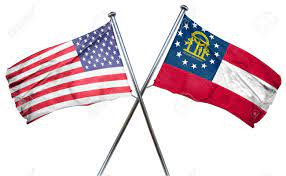
BOBCAT Battalion Color/Honor Guard
Color/Honor Guard
The Color Guard is a special organization that represents the BOBCAT Battalion by ceremonially presenting the Colors (National Flag) at school and community events. They appear at community parades, and special functions hosted by DCHS and community organizations. The Color Guard also competes in competitive events with the Drill Team.
The Honor Guard raises the National Flag prior to the start of every school day on the flag pole located in the center of the school. They are also responsible for retiring the Flag (removing it from the flag pole) immediately following the school day. The Honor Guard must belong to more than one team as well as be a productive part of the JROTC staff.
COLOR GUARD AWARDS:
Ribbon (N 3-6) = participate in one (1) Color/Honor Guard event.
Color Guard Arc = participate in ten (10) Color Guard events.
Honor Guard Arc = participate in five (5) Honor Guard events.
Color Cord = participate in twenty (20) Color/Honor Guard events.
Color (Block H) = participate in thirty (30) Color/Honor Guard events.
Practice: With Drill Team: Tuesday, Thursday 3:25 - 4:30.
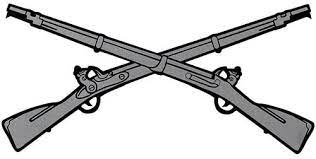
BOBCAT Battalion Drill Team
The Drill Team is a special team, which represents the BOBCAT Battalion, marching as a unit during school and community events. They participate in competitions, where they are graded on precision, synchronization, and accuracy of movement during individual, squad, and platoon drill and ceremony. The following is a list of competitive drill events that the Drill Team trains for and competes in during a drill meet.
1. Squad Basic without Arms
2. Squad Basic with Arms
3. Platoon Basic without Arms
4. Platoon Basic with Arms
5. Squad Exhibition without Arms
6. Platoon Exhibition without Arms
7. Squad Exhibition with Arms
8. Platoon Exhibition with Arms
9. Individual Exhibition with Arms
10. Duet Exhibition with Arms
11. Color Guard12. Knockout Drill (With/Without Arms)
Grading drill team events will be done in accordance with guidance provided in the respective drill meet Standard Operating Procedures and FM 21-2-5. All events are timed and have a set sequence of commands that the unit must perform to standard.
Squads, with squad leader, will consist of at least 7 members and not more than 9 members. Platoons, with platoon leader, will consist of at least 13 members and not more than 17 members. Unit leaders will carry the same equipment as their unit.
Color Guards will consist of four members, and they are required to use authorized demilitarized rifles. Color Guards will carry the National Colors and State Colors, as a minimum, for all presentations.
Only the demilitarized M-1, M-14, M-1903, or the Cadet Command Facsimile approved rifle will be used by the Drill Team. The Cadet Command Facsimile approved rifle weighs approximately the same as a demilitarized M-1 and has the same size and features.
DRILL TEAM AWARDS:
Ribbon (N 3-4) = participate in one (1) drill meet event.
Drill Team Arc = participate in ten (10) separate drill meet events.
Drill Team Cord = participate in twenty (20) drill meet events.
Drill Team Letter (Block H) = participate in thirty (30) drill meet events.
Practice: Tuesday, Thursday, 3:25 – 4:30.
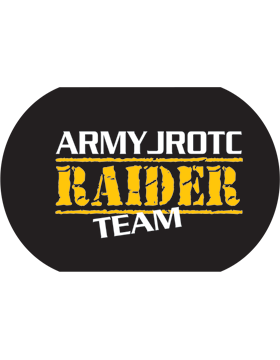
BOBCAT Battalion Raider Team
Team
The Raiders Team builds expertise in outdoor adventure and survival skills. It provides the JROTC cadets with a competitive program in mentally and physically training events: Team Physical Fitness Challenge, 5-Kilometer Road march, Litter Carry, Fireman's Carry Relay, Pull-ups, and Vehicle Pull.
They also participate in community service projects.
Raider Team members have a physical workout at each practice where the emphasis is on upper-body strength and cardiovascular fitness. Along with the everyday Physical Training, Team members work on individual events as mentioned above. The workload of an average Raider Team member will prepare them for the various annual competitions against Raider Teams of other High Schools.
The Team Physical Fitness Challenge will consist of activities that challenge a team’s physical fitness, stamina, agility, and cardio. The challenge requires an eight (8) member team during Daylight to complete a course of various events; such as individual low crawl, tire flip, heavy object carry, and water can carry, as a team.
5-Kilometer Road March requires an eight (8) member team to complete the course as a team during Daylight, under existing weather conditions, and carrying all items of prescribed equipment within 60 minutes.
The Litter Carry requires the safe transport of a simulated casualty on a litter, 200 - 400 yards, maneuvering through obstacles. Teams will be provided a simulated casualty on a liter, during daylight hours, and under existing weather conditions. Each team will consist of eight (8) raiders, the uniform will be a full raider meet field uniform. The team must transport the casualty on the litter without the simulated casualty falling off the litter. Teams may walk or run the course. All eight (8) team members must participate in the events.
RAIDER TEAM AWARDS:
Ribbon (N 3-8) = participate in one (1) Raider meet event.
Raider Team Arc = participate in ten (10) separate Raider meet events.
Raider Team Cord = participate in twenty (20) Raider meet events.
Raider Team Letter (Block H) = participate in thirty (30) Raider meet events.
Practice: Monday, Wednesday 3:25 -4:30 PM.
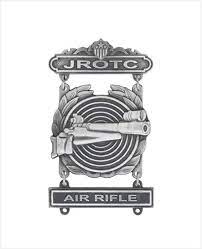
BOBCAT Battalion Rifle Team
Rifle Team
The Rifle Team trains for and competes in rifle matches against JROTC and other high school rifle teams in South Georgia and other states. Individual team members, as well as the entire team, are eligible to progress through state and national level competitions. The team consists of male and female shooters who are trained in firearm safety and shoot competitive grade air rifles, Crosman Challenger PCP.
Each team will consist of four firers. Firers on teams with less than four firers may only compete for individual trophies.
Ten Shots from each of the prone, standing and kneeling positions will be fired. One ten-meter, ten-bull target for each position with two sighting bulls will be used. Firers will be given sufficient time to zero their rifle using the prone position target sighting bulls. The order of firing will be prone, standing, and then kneeling. Firers will be given 10 minutes to complete the prone firing phase, 20 minutes to complete the standing firing phase, and 15 minutes to complete the kneeling firing phase. Firers may fire at the sighting bull on the standing and kneeling target, but they will not be given additional time to fire or be allowed to go down range to check their targets. Each bull target is worth a maximum score of 10, therefore, making each firing position worth a maximum of 100 points. All three firing positions target scores are added together to determine the individual's score during the match.
The firing distance will be thirty-three feet from the firing line to the face of the target.
RIFLE TEAM AWARDS:
Ribbon (N 3-7) = selected for the DCHS Rifle Team.
Rifle Team Arc = participate in two (2) Head to Head Rifle Competition events.
Rifle Team Cord = participate in three (3) Head to Head Rifle Competition events.
Rifle Team Letter (Block H) = participate in four (4) Head to Head Rifle Competition events.
The BOBCAT Battalion will have a maximum of two teams, an A-Team & B Team, with a maximum of five (5) shooters per team. Try-outs will be conducted in the month of August, where the top 10 shooters will be selected. Practice will start after selection.
Practice: A-Team — Monday , Wednesday. Time: 3:25 – 4:30.
BOBCAT Battalion Required Forms
The attached forms are required to be on file for each cadet.
1. Enrollment Form - Provides general information on each cadet.
2. Health Form - Provides any health concerns about the cadet.
3. Uniform Contract Form - Contract between the Cadet, Parent/Guardian, and the JROTC Instructor that states the Cadet must wear his/her uniform as part of the program.
4. Responsibility Form -The Cadet is responsible for the daily upkeep of the Uniform once issued to them.
5. Privacy Form - No personal information will be released to any unauthorized personnel or agencies.
6. Picture Release Form - Gives the BOBCAT Battalion permission to post pictures of the respective cadet on the website, bulletin board, and/or JROTC area.

Mission
The Mission of Dooly County Schools in partnership with parents and the community, is to provide students with a rigorous, standards-based curriculum that will promote college and career readiness and foster productive citizenship.

